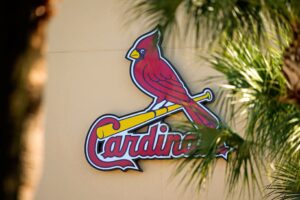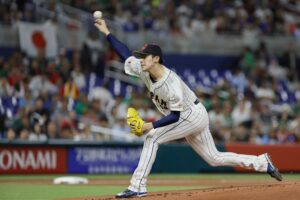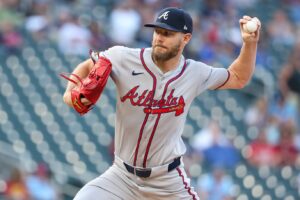The 2020 MLB season was historic for many reasons, but especially so for the Los Angeles Dodgers and their fans. The Dodgers cruised through their 60-game schedule en route to an eighth consecutive division title. Their 43-17 record was the best by win percentage since the 1954 Cleveland Indians – a record which would put them on pace for 116 wins in a full season. They lost only one series all year, in early September against the Colorado Rockies. After claiming the top seed and surviving the inaugural Wild Card Series, the Dodgers propelled through the playoffs and won their first World Series since 1988.
Everything seemed to click for the Dodgers on the field in 2020, culminating in a historic and cherished World Series championship. Let’s take a look at what specifically worked out for the Dodgers along the way.
Offense Rallies around New Superstar
Betts Acquired and Signed
The Dodgers made their most significant acquisition in years when they acquired outfielder Mookie Betts from the Boston Red Sox in February. Then, days before the truncated season began in July, Los Angeles signed him to a 12-year contract extension. This move signified the organization’s urgency in their quest to finally win a championship.
Betts settled in as the leadoff hitter a couple of weeks into the season. He hit .292/.366/.562 with 16 home runs, earning a finalist spot for NL MVP. Perhaps his most memorable contributions to the team were his string of brilliant defensive plays and crucial baserunning in the postseason. Betts showed why his impact goes beyond the batter’s box, and Dodgers fans should feel confident in him as a team leader for the coming decade.
Best Dodgers Lineup in Years
Led by Betts, the Dodgers offense was the most dangerous in baseball, putting up 5.82 runs per game to lead the league. Using the newly universal DH to their advantage, the offense also led the league in home runs and finished second in OPS. In August, they set an NL record for home runs in a month with 57.
There were several bright spots on the offensive side of things, but perhaps the most exciting sign was the dazzling return of shortstop Corey Seager. A highly prized rookie in 2016, Seager has dealt with injury issues nearly his whole career. In 2020, his first fully healthy season since 2016, Seager hit 15 home runs and finished second among shortstops with a .943 OPS. In the postseason, he elevated his game, hitting eight home runs with a 1.171 OPS. Seager, a free agent after next year, has blossomed into one of the best infielders in baseball.
Behind Betts and Seager, the Dodgers put together a powerful lineup every night. Justin Turner, despite losing some power numbers, was a consistent bat in the three-hole down the stretch. Max Muncy and Cody Bellinger fought off slumping starts and eventually came up big in the postseason. 25-year-old Will Smith established himself as one of the best offensive catchers in baseball. AJ Pollock, Joc Pederson, Chris Taylor, and Enrique Hernandez filled in when needed to complete the best offense in baseball.
Pitching Staff Shines
Kershaw and Buehler Lead Rotation
The starting rotation was, as expected, led by Clayton Kershaw and Walker Buehler. Kershaw finished 6-2 with a 2.16 ERA and 9.6 K/9, his most effective season since 2015. He capped off a brilliant year with two stellar World Series starts, going 11 2/3 innings with 14 strikeouts and only three earned runs. Buehler, on the other hand, got off to a slow start because of some minor injuries. He was utterly dominant in late October though, going 17 innings in three starts in the NLCS and World Series, allowing only two earned runs and striking out 23. Buehler looks poised to be an ace for years to come.
Collective Effort Gets the Job Done
Tony Gonsolin, Dustin May, and Julio Urias also manned the pitching staff for most of the year. All three youngsters built on promising starts to their careers, and the team likes where they stand going forward. Gonsolin had a 1.94 ERA and 0.77 WHIP in eight regular season starts. May furthered his development by throwing the second most innings, 56, on the staff. Urias became a postseason legend, closing out both the NLCS and World Series in relief. He finished with three earned runs allowed in 25 postseason innings.
To make matters worse for their opponents, the Dodgers’ bullpen became one of the most effective units in the league. Dodgers’ relievers combined for a 2.74 ERA in the regular season, the best in the NL. Breakout seasons from several pitchers contributed to the success of the bullpen. Rookies Brusdar Graterol and Victor Gonzalez, for example, developed into high-leverage utility relievers. Veterans Blake Treinen and Jake McGee had terrific rebound seasons in their first year in Los Angeles. Kenley Jansen remained, for the most part, a stable closer at the back end for the Dodgers. All in all, the bullpen, which had been a liability in years past, became a hidden strength.
Postseason Glory Finally Achieved
The Dodgers entered the 2020 season in a familiar place: with World Series championship expectations. After cruising through the regular season and sweeping their way to the NLCS, Los Angeles was poised to celebrate for the first time since 1988. But soon thereafter, the Dodgers found themselves in another familiar position – on the brink of elimination – down 3-1 against the Atlanta Braves. Their story was writing itself all over again as the best team in baseball began to collapse in October.
Behind a brilliant collective effort, however, the Dodgers changed the narrative and came back to defeat the Braves. Then they beat the Rays, four games to two, in the World Series. Corey Seager had a truly special performance, slugging his way to NLCS and World Series MVP honors. For the Dodgers and their fans, the unusual 2020 season will be remembered by how it ended. After years of frustration, the Dodgers finally put together a historic and improbable championship run.
The final out. #WorldSeries pic.twitter.com/d0rOut8iJN
— Los Angeles Dodgers (@Dodgers) October 28, 2020
Main Photo
Embed from Getty Images






